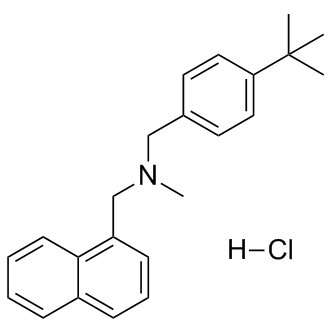
Butenafine hydrochloride
CAS No. 101827-46-7
Butenafine hydrochloride( —— )
Catalog No. M10086 CAS No. 101827-46-7
A synthetic benzylamine antifungal that inhibits the synthesis of ergosterol by inhibiting squalene epoxidase.
Purity : >98% (HPLC)
 COA
COA
 Datasheet
Datasheet
 HNMR
HNMR
 HPLC
HPLC
 MSDS
MSDS
 Handing Instructions
Handing Instructions
| Size | Price / USD | Stock | Quantity |
| 200MG | 28 | In Stock |


|
| 500MG | 48 | In Stock |


|
| 1G | 73 | In Stock |


|
Biological Information
-
Product NameButenafine hydrochloride
-
NoteResearch use only, not for human use.
-
Brief DescriptionA synthetic benzylamine antifungal that inhibits the synthesis of ergosterol by inhibiting squalene epoxidase.
-
DescriptionA synthetic benzylamine antifungal that inhibits the synthesis of ergosterol by inhibiting squalene epoxidase; displays superior activity against Candida albicans than terbinafine and naftifine; demonstrates low MICs against Cryptococcus and Aspergillus.Fungal Infection Approved(In Vitro):Butenafine Hydrochloride, a benzylamine derivative, is an antifungal which is used to control dermal fungal infections such as athletes foot and ring worm. Butenafine Hydrochloride is squalene epoxidase inhibitor, inhibits the synthesis of ergosterol needed in fungal cell membranes. The drug has excellent penetration into the epidermis and a prolonged retention time following topical application, conferring residual therapeutic activity after treatment cessation. Butenafine possess anti-inflammatory activity too. Butenafine hydrochloride 1% cream is safe and effective for tinea corporis cruris and tinea manuum pedis.
-
In VitroButenafine Hydrochloride, a benzylamine derivative, is an antifungal which is used to control dermal fungal infections such as athletes foot and ring worm. Butenafine Hydrochloride is squalene epoxidase inhibitor, inhibits the synthesis of ergosterol needed in fungal cell membranes. The drug has excellent penetration into the epidermis and a prolonged retention time following topical application, conferring residual therapeutic activity after treatment cessation. Butenafine possess anti-inflammatory activity too. Butenafine hydrochloride 1% cream is safe and effective for tinea corporis cruris and tinea manuum pedis.
-
In Vivo——
-
Synonyms——
-
PathwayMicrobiology/Virology
-
TargetFungal
-
RecptorSqualeneepoxidase
-
Research AreaInfection
-
IndicationFungal Infection
Chemical Information
-
CAS Number101827-46-7
-
Formula Weight353.9281
-
Molecular FormulaC23H28ClN
-
Purity>98% (HPLC)
-
Solubility10 mM in DMSO
-
SMILESCl.CN(CC1=CC=C(C=C1)C(C)(C)C)CC1=CC=CC2=CC=CC=C12
-
Chemical Name1-Naphthalenemethanamine, N-[[4-(1,1-dimethylethyl)phenyl]methyl]-N-methyl-, hydrochloride (1:1)
Shipping & Storage Information
-
Storage(-20℃)
-
ShippingWith Ice Pack
-
Stability≥ 2 years
Reference
molnova catalog



related products
-
Quilseconazole
A novel selective, orally available fungal CYP51 (lanosterol 14-α-demethylase) inhibitor.
-
Cerulenin
An antifungal antibiotic that inhibits fatty acid synthase (FASN), also blocks cellular proliferation of KRAS-associated lung cancer cells.
-
APX001
APX001 (APX 001A;E1210) is a novel broad-spectrum antifungal agent that inhibits the fungal protein Gwt1.



 Cart
Cart
 sales@molnova.com
sales@molnova.com


